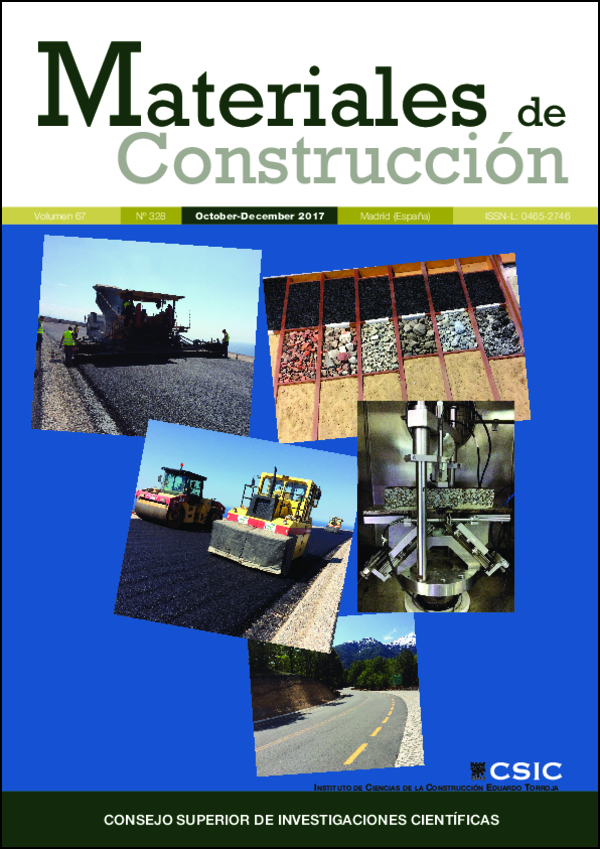Eco-trench: a novel trench solution based on reusing excavated material and a finishing layer of expansive concrete
DOI:
https://doi.org/10.3989/mc.2017.05316Keywords:
Concrete, Mixture proportion, Expansion, Finite element method, ShrinkageAbstract
Installing utility pipelines generates a significant amount of trench arisings, which are usually transported to landfills instead of being reused as backfill material. This practice generates CO2 emissions and wastes raw materials. This paper presents a more sustainable solution, an eco-trench, which is based on re-using trench arisings as backfill and adding a top layer of expansive concrete to improve the eco-trench’s structural performance. The technical feasibility of the eco-trench was evaluated through a finite element model, which identified the degree of expansion in concrete required to avoid failure or subside the stresses caused by traffic. The potential expansion of concrete was measured under confined conditions in the laboratory by means of a novel test developed for this purpose. The results showed that adding calcium oxide generates the required internal stress. The results were then confirmed in a pilot experience.
Downloads
References
Etxebarria, M.; Ainchil, J.; Pérez, M.E.; González, A. (2013). Use of recycled fine aggregates for Control Low Strength Materials (CLSMs) production. Constr. Build. Mater. 44, 142–148. https://doi.org/10.1016/j.conbuildmat.2013.02.059
Blanco, A.; Pujadas, P.; Cavalaro, S.H.P.; Aguado, A. (2014). Methodology for the design of controlled lowstrength materials. Application to the backfill of narrow trenches, Constr. Build. Mater. 72, 23–30. https://doi.org/10.1016/j.conbuildmat.2014.09.008
Pujadas, P.; Blanco, A.; Cavalaro, S.; Aguado, A. (2015). Performance-Based Procedure for the Definition of Controlled Low-Strength Mixtures. J. Mater. Civil Eng. https://doi.org/10.1061/(ASCE)MT.1943-5533.0001283
Petit-Boix, A.; Roigé, N.; de la Fuente, A.; Pujadas, P.; Gabarrell, X.; Rieradevall, J.; Josa, A. (2016). Integrated Structural Analysis and Life Cycle Assessment of Equivalent Trench-Pipe Systems for Sewerage. Water Resour. Manag. 30 [3], 1117–1130. https://doi.org/10.1007/s11269-015-1214-5
WRAP (Waste & Resources Action Program). (2005). Identifying opportunities for recycling of excavated spoil from utility works within local authority areas, and promoting the use of recycled materials through good practice in procurement. Banbury, U.K.
WRAP (Waste & Resources Action Program). (2007). Recycled and stabilised materials in trench reinstatement, WAS005-002: Final Report, Banbury, U.K.
Chatterji, S. (1995). Mechanism of expansion of concrete due to the presence of dead-burnt CaO and MgO. Cem. Concr. Res. 25, 51–56. https://doi.org/10.1016/0008-8846(94)00111-B
Min, D.; Dongwen, H.; Xianghui, L.; Mingshu, T. (1995). Mechanism of expansion in hardened cement pastes with hard-burnt free lime. Cem. Concr. Res. 25 [2], 440–448. https://doi.org/10.1016/0008-8846(95)00030-5
Maltese, C.; Pistolesi, C.; Lolli, A.; Bravo, A.; Cerulli, T.; Salvioni, D. (2005). Combined effect of expansive and shrinkage reducing admixtures to obtain stable and durable mortars. Cem. Concr. Res. 35[12], 2244–2251. https://doi.org/10.1016/j.cemconres.2004.11.021
Carballosa, P.; Calvo, J.L.G.; Revuelta, D.; Sanchez, J.J.; Gutierrez, JP. (2015). Influence of cement and expansive additive types in the performance of self-stressing and self-compacting concretes for structural elements. Constr. Build. Mater. 93, 223–229. https://doi.org/10.1016/j.conbuildmat.2015.05.113
Pade, C.; Guimaraes, M. (2007). The CO2 uptake of concrete in a 100-year perspective. Cem. Concr. Res. 37 [9], 1348– 1356. https://doi.org/10.1016/j.cemconres.2007.06.009
Yang, K-H.; Seo, E-A.; Tae, S-H. (2014). Carbonation and CO2 uptake of concrete. Environmental Impact Assessment Review. 46, 43–52. https://doi.org/10.1016/j.eiar.2014.01.004
TNO Diana BV. (2008). Diana User´s Manual, (http://www. tnodiana.com/)
Ecole d'Avignon. (2005). Techniques et pratique de la chaux. Eyrolles, Ed. 2nd edition, Paris, France. PMid:16192769
ASTM (American Society for Testing and Materials). (1995). C806-95 Standard Test Method for Restrained Expansion of Expansive Cement Mortar 1, West Conshohocken, PA.
ASTM (American Society for Testing and Materials). (2009). C878/C878M-09 Standard Test Method for Restrained Expansion of Shrinkage-Compensating Concrete, West Conshohocken, PA.
Formosa, J. (2012). Formulaciones de nuevos morteros y cementos especiales basadas en subproductos de magnesio. Doctoral Thesis, Universitat de Barcelona, Barcelona, (in Spanish).
AENOR (Spanish Association for Standardization and Certification). (2005). UNE-EN 196-1:2005. Methods of testing cement - Part 1: Determination of strength, Madrid, Spain.
CEN (European Committee for Standardization). (2009). EN12390-3:2009. Part 3: Compressive strength of test specimens, Brussels, Belgium.
Published
How to Cite
Issue
Section
License
Copyright (c) 2017 Consejo Superior de Investigaciones Científicas (CSIC)

This work is licensed under a Creative Commons Attribution 4.0 International License.
© CSIC. Manuscripts published in both the print and online versions of this journal are the property of the Consejo Superior de Investigaciones Científicas, and quoting this source is a requirement for any partial or full reproduction.
All contents of this electronic edition, except where otherwise noted, are distributed under a Creative Commons Attribution 4.0 International (CC BY 4.0) licence. You may read the basic information and the legal text of the licence. The indication of the CC BY 4.0 licence must be expressly stated in this way when necessary.
Self-archiving in repositories, personal webpages or similar, of any version other than the final version of the work produced by the publisher, is not allowed.
















